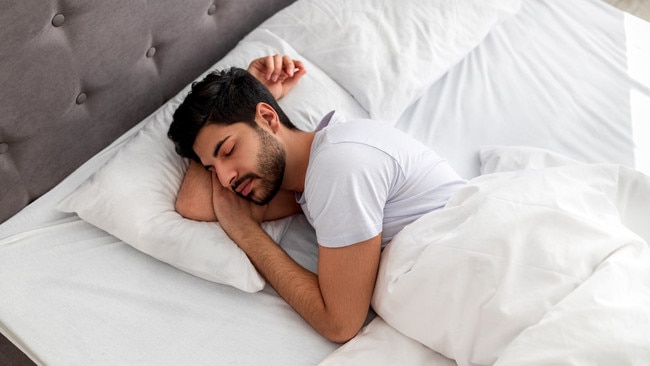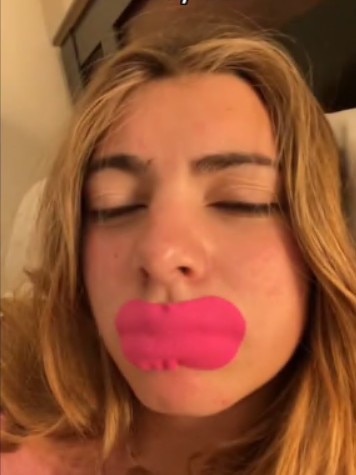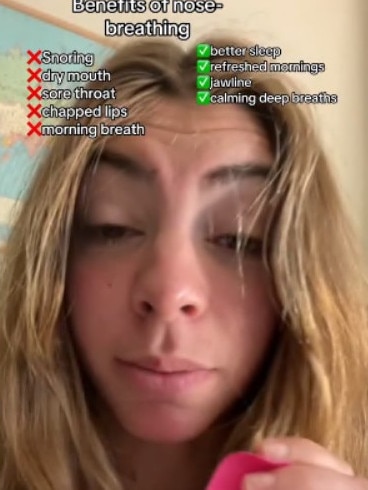The truth behind the TikTok hype on mouth taping
Some influencers claim this one simple step could ease a lot of health issues, including bad breath and snoring – but is it safe?
Illness
Don't miss out on the headlines from Illness. Followed categories will be added to My News.
Welcome to Ask Doctor Zac, a weekly column from news.com.au. This week, Dr Zac Turner reveals the truth about mouth taping.
QUESTION: Hi Dr Zac, I’ll be the first to admit I spend way too much time scrolling TikTok – lately, my FYP (for you page) is full of people raving about mouth taping. I know nasal breathing is supposed to be better for filtering air, but some influencers claim it can also help with dry mouth, bad breath, snoring, teeth grinding, and even jaw definition. The idea of taping my mouth shut at night makes me nervous. What if my nose gets blocked and I can’t breathe? Also, I remember hearing as a kid that we swallow bugs in our sleep – so wouldn’t mouth tape stop that, too? Or is that whole bug thing just a myth? I’d love to know if mouth taping is actually safe and if it lives up to the hype. – Rochelle, 31, Gosford, NSW
ANSWER: If you’ve been sucked into the vortex of TikTok trends, welcome to the club. I’ve seen the mouth taping craze too, and it’s hard not to get intrigued. Influencers make it sound like a magic fix for everything: Snoring? Gone. Bad breath? Solved. Teeth grinding? Say no more. Even jaw definition? Why bother with Kim Kardashian contouring when you’ve got tape?
But let’s get real for a second – taping your mouth shut while you sleep sounds … well, a little unhinged. What if your nose gets blocked? Do we really swallow bugs in our sleep, and would the tape save us from this nightmare fuel?
Let’s dig into what’s fact, what’s fiction, and whether this TikTok trend is worth your time – or your tape.
Why everyone’s obsessed with nasal breathing
Breathing through your nose is kind of like upgrading to first class on a flight: It’s just better. Your nose is a multi-tasking superhero – it filters, warms and humidifies the air before it hits your lungs. Bonus? It produces nitric oxide, a molecule that enhances oxygen uptake and has antimicrobial properties.
Mouth breathing, on the other hand, is like flying economy on a budget airline. Sure, it gets the job done, but it skips the fancy perks.
Chronic mouth breathing can lead to dry mouth, bad breath, disrupted sleep and even higher risks of infections.

When you sleep, your body is on autopilot, and if you’re a mouth breather, you’re missing out on those nasal perks. Chronic mouth breathing is also linked to snoring, sleep apnoea and even changes in facial structure over time.
Research published in Sleep Medicine Reviews highlights how nasal breathing improves oxygen exchange and reduces sleep disruptions. Similarly, studies in the Journal of Clinical Sleep Medicine support the importance of nasal breathing for reducing risks like obstructive sleep apnoea.
The big idea behind mouth taping
The mouth taping trend claims to nudge your body back into nasal breathing by – quite literally – sealing the deal. It’s supposed to prevent you from breathing through your mouth, helping you wake up refreshed and, apparently, more attractive (jawline goals, anyone?)
But is it safe? And does it actually work?
The good, the bad and the sticky
Let’s start with the good: Encouraging nasal breathing is a worthy goal. Research shows that nasal breathing improves oxygenation, reduces snoring and might even make you feel more rested. So, in theory, mouth taping could help – if you’re already capable of breathing through your nose.
But here’s the sticky part: If your nose is congested (hello, allergies) or you have structural issues like a deviated septum, mouth taping could lead to serious problems. Imagine waking up in the middle of the night unable to breathe. Not exactly the beauty sleep you were hoping for.
There’s also the potential for skin irritation. Not all tapes are skin-friendly, and waking up with a rash around your mouth is hardly the glamorous TikTok vibe we’re going for.
And about those bugs? The idea that we swallow spiders in our sleep is a total myth. No self-respecting spider is crawling into a warm, snoring mouth.
So while tape might help you sleep with peace of mind, it’s not saving you from an eight-legged midnight snack.
Better (and safer) ways to promote nasal breathing
If you’re tempted by mouth taping but aren’t sold on the idea of turning your face into a makeshift arts-and-crafts project, don’t worry – there are other ways to improve nasal breathing.
Clear your nose
Stuffy noses are the enemy of nasal breathing, but forcing pressure up your nostrils all the time to clear them can sometimes make matters worse. It may compact an already boggy area. Instead, or alongside this, consider using a neti pot or similar device. These tools allow water to flow gently from one nostril through the sinuses and out the other nostril. It can feel a bit odd as you sense the water circulating, but it’s a gentle way to move things along without the pushing and shoving that can happen when you’re blocked and repeatedly inhaling forcefully. Studies in Respiratory Medicine have demonstrated the benefits of saline irrigation for clearing sinus blockages safely and effectively.
Strengthen your airway muscles
Ever heard of myofunctional therapy? It’s basically physical therapy for your face.
These exercises strengthen your tongue and airway muscles, which can help keep your breathing on track.
Research in European Respiratory Journal highlights myofunctional therapy’s potential to support airway health and reduce snoring.

Switch up your sleep position
Back sleepers are more likely to mouth breathe.
Try sleeping on your side to encourage nasal breathing. But be mindful of how you position yourself – if you faceplant into your pillow all night, you’re not giving your body the openness it needs.
Putting a pillow between your legs and hugging another pillow can help your body feel more open, improve circulation and even reduce wrinkles.
When your body is aligned, your breathing can improve significantly.
Practice makes perfect
You don’t need to go straight to taping your mouth shut at night. Like any kind of training, it’s best to ease into it.
Start by practising mouth taping during the day while doing safe, low-risk activities, like driving or relaxing at home.
This helps you get used to the sensation and ensures you can still breathe comfortably through your nose.
Prep the tape
I always carry a little micropore tape with me (it’s surprisingly handy for fixing all kinds of things).
When using tape for your mouth, tear off a small amount and stick it to your palm a few times first to reduce the stickiness. This makes it gentler on your lips, which are very sensitive.
Remember, many parts of our body need time to adjust to new things, so go slow and take it easy. It’s not a race.


Check for structural issues
If you’ve got a deviated septum or other anatomical problems, no amount of tape is going to fix it. See an ENT (ear, nose, throat) specialist to discuss solutions like surgery or other treatments.
Teach your kids (and maybe your parents)
Mouth breathing isn’t just an adult problem. Kids who mouth breathe might develop dental issues or sleep disturbances, and older adults might struggle due to age-related changes. Encourage good nasal hygiene for everyone in the family.
Should you try it?
So, to tape or not to tape? Mouth taping isn’t inherently dangerous, but there’s not enough scientific evidence to back up the suggested benefits, so most doctors wouldn’t recommend it, especially when there are other proven solutions out there.
If you’ve got nasal congestion, sleep apnoea or a general sense of unease about taping your mouth shut, I would recommend giving it a pass.
Ultimately, the goal is to promote healthy, natural nasal breathing – and there are plenty of ways to achieve that without resorting to TikTok’s latest trend.
Got a question? Email askdrzac@conciergedoctors.com.au
Follow Dr Zac on Instagram
Dr Zac Turner is a medical practitioner specialising in preventive health and wellness. He has four health/medical degrees – Bachelor of Medicine/Bachelor of Surgery at the University of Sydney, Bachelor of Nursing at Central Queensland University, and Bachelor of Biomedical Science at the University of the Sunshine Coast. He is a registrar for the Australian College of Rural and Remote Medicine, and is completing a PhD in Biomedical Engineering (UNSW). Dr Zac is the medical director for his own holistic wellness medical clinics throughout Australia, Concierge Doctors.
Originally published as The truth behind the TikTok hype on mouth taping





